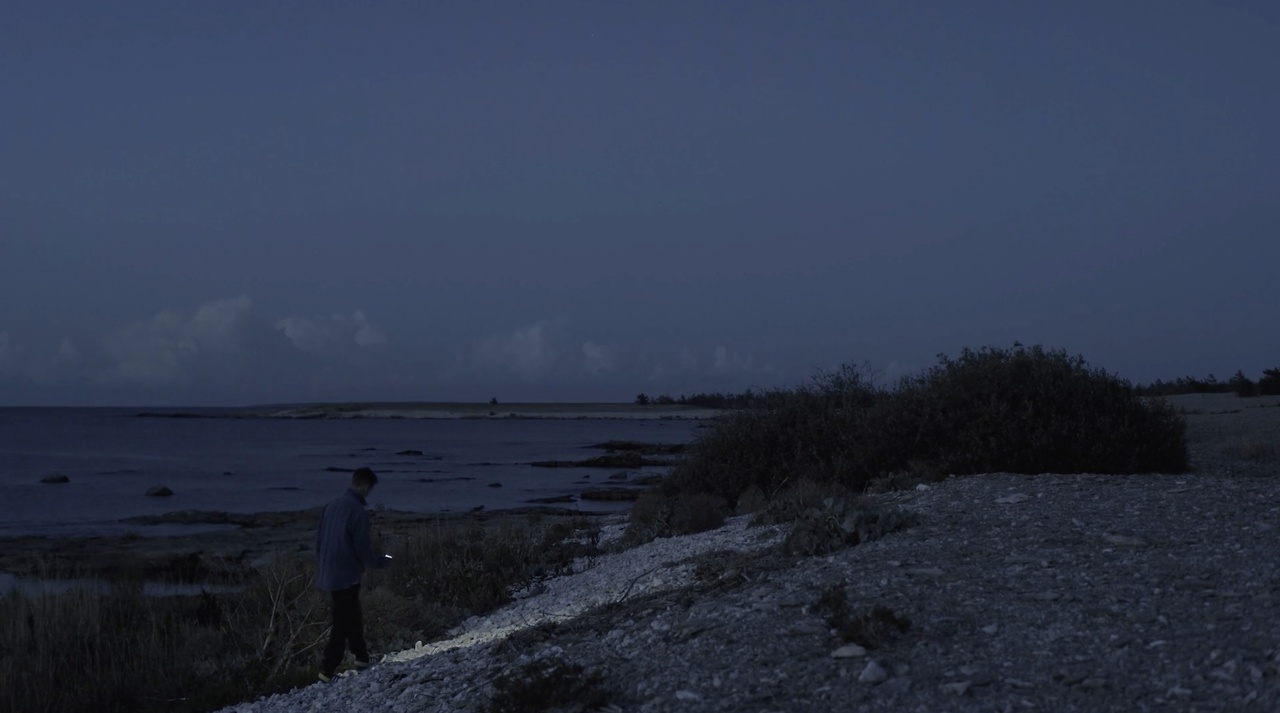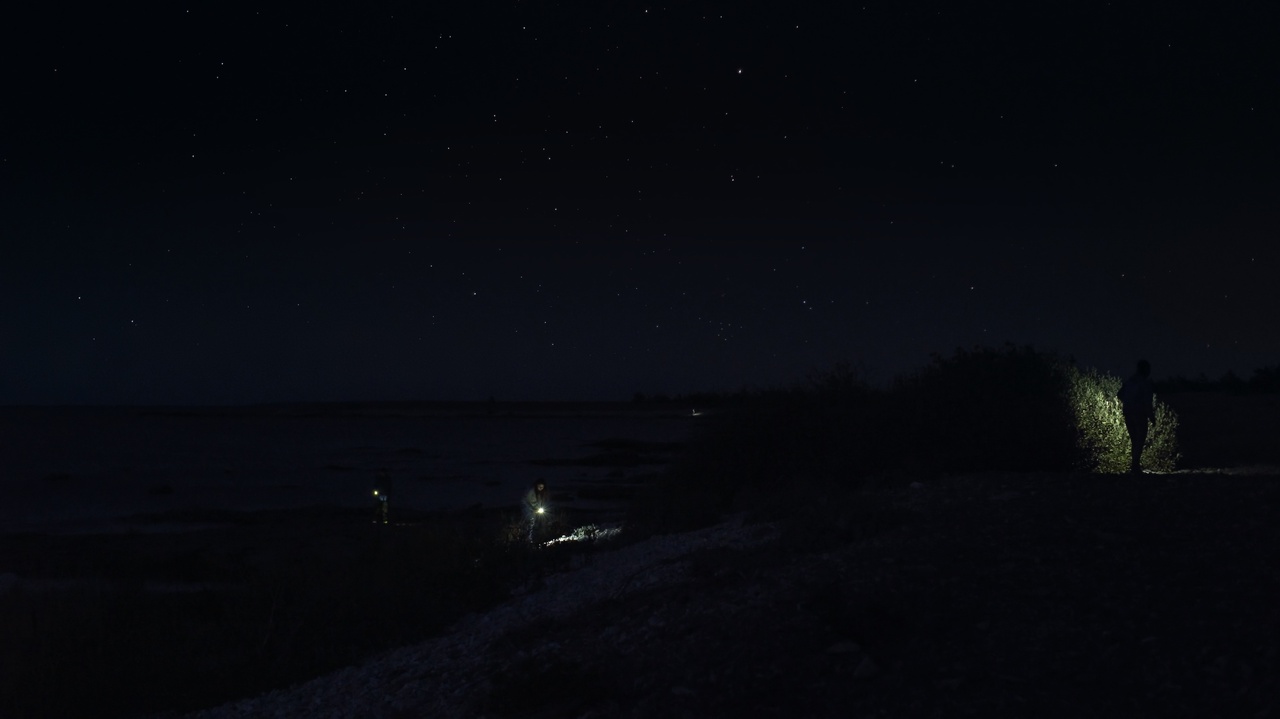PAINTING WITH LIGHT Jennifer Lynn Peterson on Sharon Lockhart’s film “EVENTIDE”

Sharon Lockhart, “EVENTIDE,” 2022, film still
A painterly meditation on cinema and light, Sharon Lockhart’s stunning new work EVENTIDE (2022) is a 30-minute single-take film in which the sun sets and the stars come out over a seashore on the island of Gotland, Sweden. As the piece opens, there is no direct sun but still enough light to see the medium blue of the ocean and the dimming sky. Human figures enter the scene one-by-one, carrying small lights that they train on the ground, as if searching for something. These small pools of light are soon echoed by the starlight emerging in the darkening night sky. The figures continue their search – for what, we do not know. Occasionally, a meteor streaks spectacularly across the sky; satellites appear too, moving steadily. Our eyes are drawn to these various small lights moving around the frame, lights that give the piece a dramatic, enigmatic intensity reminiscent of a Rembrandt painting.
Directors who shoot during golden hour often emphasize the warm light of the setting sun, but Lockhart, in this piece, is invested in the night sky, exploring the darkening blues of nightfall with a captivating precision. Informed by art historical precedents in painting as much as by cinema and photography, EVENTIDE uses chiaroscuro as an organizational principle. The figures are staged in depth, the farthest one located on a distant peninsula, and none of their faces can be discerned. The emphasis on depth in the landscape is magnified a thousandfold by the distance of the stars in the sky, creating a dual perspective of human-scale and planetary-scale space. This adds ecological resonance to the piece, which presents human figures as dwarfed by the landscape.
The six figures who ultimately gather and move about the scene wear gender-neutral street clothing (jeans, jackets, sneakers). The first one to enter the frame has short cropped hair, the others wear their hair long. All move with a gracefulness that feels dancelike, though they are not performing a traditional dance. Rather, they enact a quiet drama of care and concern, their feminine – or perhaps agender – energy creating a space of contemplation, protection, and refuge. The sense of refuge is deepened further by the film’s evocation of a specific Rembrandt painting, Landscape with the Rest on the Flight into Egypt (1647), which depicts a night scene in which a small group of figures (the Holy Family) have found sanctuary beside a body of water, lit by a pool of firelight. As in that painting, trouble is present in EVENTIDE, but outside the frame; the film gives us pause to interrogate it.

Sharon Lockhart, “EVENTIDE,” 2022, film still
Without trumpeting itself, EVENTIDE does nothing less than reenvision the sublime for our era of environmental, economic, and political precarity. The piece manages to evoke Renaissance paintings and 19th-century seascapes while at the same time, with its young protagonists, satellites, and ultra-realistic high-resolution video, appearing entirely contemporary. Sound is also hugely important in EVENTIDE, where it functions as a sensory tool to focus our attention. The ocean’s roar, later accompanied by the sounds of insects humming, produces a low and constant white-noise element, offset by the louder, satisfying sound of feet crunching on rocks as the figures move around. Eventually, subtle musical tones join in, adding a careful touch of artifice to the scene.
EVENTIDE’s coastline setting is both beautiful and unremarkable: no crashing waves, high cliffs, or sculptural trees, but rather scrub brush, rocks, and a flat promontory in the distance. Much of the natural drama here appears in the skies: each falling star produces a sensational rush. At the same time, this landscape is laden with film historical resonance: Gotland was the setting for numerous Ingmar Bergman films (Bergman also lived on Fårö, off the northern tip of Gotland, for the last four decades of his life). It is also worth noting that cinematographer Sven Nykvist, renowned for his work shooting under low lighting conditions, played a key role in crafting the iconographic resonance of this place; Nykvist shot Bergman films such as Persona (1966), The Passion of Anna (1969), and his TV miniseries Scenes from a Marriage (1973), as well as Andrei Tarkovsky’s final film, The Sacrifice (1986), on location in Gotland. Yet the viewer does not need to know any of this to be drawn into EVENTIDE.
Indeed, like other contemporary works that use slow pacing and long duration as essential formal elements, the references that surface from Lockhart’s film emerge from the spectator as well as the piece itself. To experience EVENTIDE means to be enveloped in its world; the film produces a particular, meditative state of consciousness, gathering the spectator’s attention through a careful use of all tools in the cinematic sensorium: light, color, sound, framing, movement, mise-en-scène. Following the dancelike movements of the investigating figures, we first study the piece as a composition of moving lights. As we settle into its slow pace, we are given space in which to meditate on a set of topics that might include not just landscape painting and film history but also technology, global warming, crime scene investigations, or the turning of the earth. At one point while watching the film, I was overcome by the realization that in the past, these constellations of stars would have been legible, whereas to most of us today, that meaning has been lost.

Sharon Lockhart, “EVENTIDE,” 2022, film still
Film scholars such as Michael Zryd and others have made a case for the “democratic ethos” of experimental film, which invites any viewer to watch and experience its perceptual shifts. [1] This democratic aspect is particularly relevant to slow durational works, which create space for the spectator’s own thoughts. And just like democracy, durational cinema also demands a particular kind of attention. In a recent book, Michael Walsh aptly describes one of the main characteristics of durational cinema: it “subtracts conventional dramatic interest.” [2] Indeed, Lockhart’s work, in concert with that of other durational filmmakers ranging from Chantal Akerman to James Benning, is entirely unconcerned with the commercial cinema’s imperative to foreground narrative, dialogue, and conventional stars. EVENTIDE instead places its humans in a landscape with a larger philosophical scope and scale. What a relief to sit with Lockhart’s film, in which the figures do not dominate the setting, and the spectator is granted space and time in which to meet the work.
Several of the key themes running throughout Lockhart’s films and still photos – gender, labor, youth – are present in this film, but they are less explicit than in earlier works. Take labor, for example. Lockhart’s film EXIT (2008) documents industrial workers leaving the Bath Iron Works in Maine in a series of five stationary long takes, in a subtle nod to the Lumière Brothers’ famous 1895 film Workers Leaving the Factory. LUNCH BREAK, shot the same year at the same iron works, shows workers eating lunch inside the plant in a long, seamless tracking shot (10 minutes slowed to 78 minutes). Double Tide (2009) depicts a female figure digging for clams on a riverbank, in two stationary shots lasting a total of 97 minutes.
Double Tide clearly presages EVENTIDE, but the type of work being performed in Lockhart’s new film has changed. The figures are still located in a setting with strong presence, but here they are exploring, gathering evidence. Lockhart is known for her meditations on choreography (in her work centered on Israeli dance composer Noa Eshkol, for example), and though the figures in this film are not dancing in any traditional sense, they move with a loose sense of choreography, performing an investigative routine with repetitive gestures (bending, looking, walking). Immersed in their search, they do not interact or acknowledge each other. EVENTIDE bestows agency and intellectual acuity upon its human figures, who might almost be scientists from an Enlightenment painting, or forensic investigators from a TV drama. As though solving a mystery, they are on the case. Their presence renders this moody seascape strangely reassuring, even as the film asks us to contemplate the earth turning in space and the place of humans on the planet, hinting at catastrophe.
Jennifer Lynn Peterson is a film scholar and writer interested in landscape, ecology, and the history and possibilities of the moving image. She is the author of Education in the School of Dreams: Travelogues and Early Nonfiction Film (Duke University Press, 2013), along with scholarly essays in journals such as Representations, Feminist Media Histories, and Camera Obscura. Her art and book reviews have been published in Millennium Film Journal, the Los Angeles Review of Books, Contemporary Art Review Los Angeles (Carla), and on Artforum.com. She lives and works in Los Angeles, where she is currently a professor of media studies at Woodbury University.
Image credit: © Sharon Lockhart, courtesy of the artist and neugerriemschneider, Berlin
